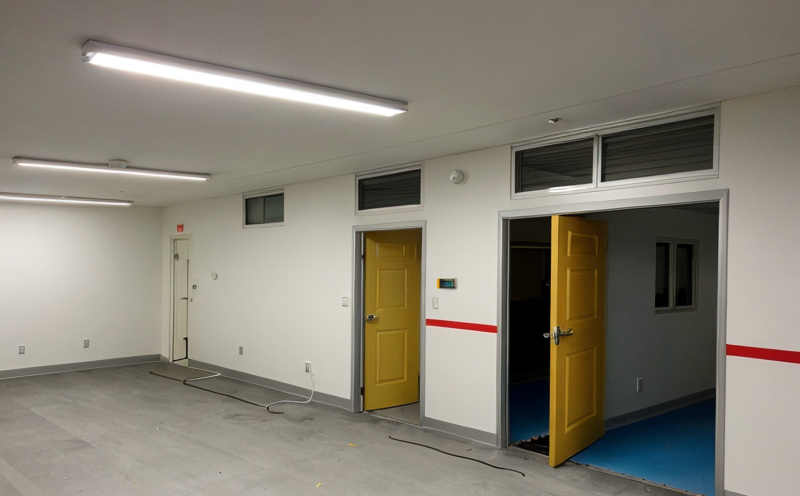EN 60598 1 Thermal Endurance Testing of Emergency Lighting Fixtures
The EN 60598 series of standards is a comprehensive set of guidelines designed to ensure the safety, reliability, and performance of lighting equipment. Specifically, EN 60598-1:2017 pertains to emergency lighting fixtures. This standard focuses on ensuring that these fixtures can operate safely under extreme conditions such as high temperatures.
The thermal endurance test evaluates the ability of an emergency light fixture to maintain its operational integrity and functionality when exposed to elevated temperatures for a specified duration. This is crucial because during power outages, or in emergencies where normal lighting fails, it's imperative that emergency lights function correctly without failure due to environmental stressors like high heat.
The test procedure involves placing the emergency light fixture inside an oven-like chamber and exposing it to controlled temperature conditions for a predetermined amount of time. The objective is to simulate real-world scenarios where the fixture might be exposed to elevated temperatures, such as during fires or other emergencies. After the exposure period, the fixture undergoes inspection to ensure that no damage has occurred which would affect its performance.
This testing process ensures compliance with international standards and helps manufacturers produce reliable products that meet regulatory requirements. Compliance not only protects end-users but also provides peace of mind for those responsible for purchasing or specifying such equipment.
The test setup typically includes a specialized oven capable of reaching temperatures up to 105°C (221°F) for durations ranging from several hours to days, depending on the specific requirements outlined in EN 60598-1. During this time, the fixture is subjected to continuous monitoring and recording of temperature fluctuations.
Once the exposure period concludes, the fixture undergoes visual inspection as well as functional tests to ensure that it remains operational after having been exposed to such conditions. If any issues are detected during these checks, they must be addressed before certification can be granted.
Scope and Methodology
| Aspect | Description |
|---|---|
| Test Conditions | The test subjects are placed in an oven capable of reaching temperatures up to 105°C (221°F). The temperature is maintained for a period specified by the standard, which can range from several hours to multiple days. |
| Measurement and Monitoring | During the test, continuous monitoring and recording of temperature fluctuations are performed using calibrated thermocouples. These measurements help ensure that the fixture is subjected to the correct environmental conditions throughout the entire exposure period. |
| Post-Testing Inspection | Upon completion of the thermal endurance test, each fixture undergoes a thorough inspection to check for any signs of damage or degradation in performance. Functional tests are also conducted to ensure that all components remain operational. |
The methodology outlined in EN 60598-1 ensures rigorous testing conditions which mimic real-world scenarios where emergency lights may be exposed to high temperatures. This approach guarantees the reliability and safety of these fixtures, thereby protecting both users and operators during critical situations.
Industry Applications
- Hospitals and healthcare facilities: Ensuring that emergency lighting functions correctly in case of power outages or fires.
- Offices and commercial buildings: Providing necessary illumination to ensure safety and facilitate evacuation during emergencies.
- Factories and industrial sites: Maintaining safe working conditions by ensuring proper visibility in case of unexpected shutdowns or accidents.
- Parking garages and underground facilities: Offering reliable lighting solutions that help people navigate safely even when normal lighting fails.
The results from this test are vital for compliance with regulatory requirements, providing assurance to end-users about the reliability and safety of emergency lighting fixtures. By meeting these standards, manufacturers can ensure their products perform consistently under challenging environmental conditions.
Why Choose This Test
Compliance with EN 60598-1:2017 is essential for several reasons. Firstly, it ensures that emergency lighting fixtures meet the highest safety standards, which is critical during emergencies when such lights could be a lifeline for evacuees or first responders.
Secondly, this testing process helps manufacturers produce reliable products by identifying potential weaknesses early on in the development cycle. It allows them to address any issues before releasing their product into the market, thereby improving overall quality and reducing risks associated with non-compliant equipment.
Thirdly, compliance with this standard provides peace of mind for those responsible for purchasing or specifying such lighting fixtures. Knowing that a fixture has undergone rigorous testing increases confidence in its ability to perform as expected under challenging conditions.
Failing to meet these standards can lead to severe consequences including liability issues and potential harm to individuals relying on the equipment during emergencies. Therefore, choosing this test is not just about meeting regulatory requirements but also about ensuring public safety and protecting your brand reputation.





